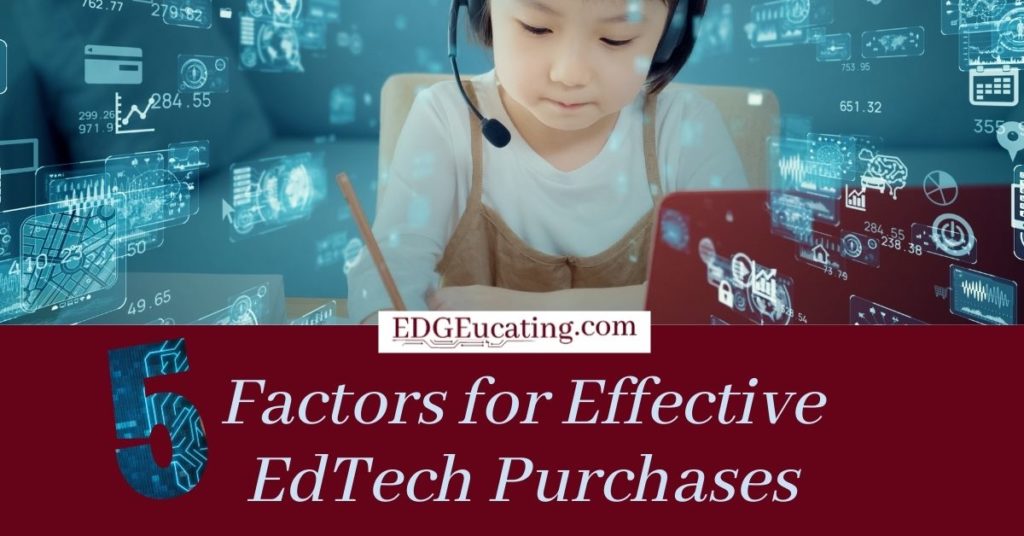As a classroom teacher turned instructional coach, I’ve seen firsthand how the right educational technology can support deeper learning. But I’ve also watched promising tools gather dust because they weren’t the right fit—or weren’t supported properly. If you’re an educator or school leader navigating edtech decisions, these five strategies will help you choose tools that truly support both teachers and students.
How the SAMR Model Helps Us Choose EdTech Wisely
Before we discuss the five strategies, it is important to understand the SAMR Model as the basis for edtech purchase decisions.
When I was teaching, I witnessed a frustrating pattern: schools buying shiny tools that never ended up in impactful lessons. So, EDGEucating was formed. Our mission? To guide educators and administrators toward making thoughtful, meaningful EdTech choices—not driven by hype, but by real teaching purpose.
As part of that mission, we turn to the SAMR Model—a framework teachers and leaders can use to evaluate the role tech plays in learning. SAMR, developed by Dr. Ruben Puentedura in 2010, stands for:
-
Substitution – Tech replacing old tools (e.g., digital worksheets instead of paper)
-
Augmentation – Tech adds helpful features (like instant feedback)
-
Modification – Tech changes how tasks get done (students collaborating with coding robots)
-
Redefinition – Tech enables completely new learning (students creating with assistive technology or coding platforms in ways we couldn’t do before, including connecting globally ).
As with any education purchase, you should always start with student needs and goals as the foundation of thoughtful EdTech procurement—reflecting the guiding principle from ISTE. Using SAMR, schools can ensure that every tool—whether it’s a digital notebook or a hands-on coding robot—serves a clear purpose in enhancing instruction.
Using these 5 strategies, we’ve seen schools successfully move from enhancement (Substitution, Augmentation) to transformation (Modification, Redefinition)—and that’s the goal. The SAMR Model reminds us there’s no one-size-fits-all; it’s about choosing the right level for each lesson, anchored by strong pedagogy.
1. Think Beyond the Price Tag—Focus on Total Cost of Ownership (TCO)
A tool may seem affordable at first, but the true cost includes training, updates, and maintenance. Our experience shows that 80% of epiphany—or frustration—comes from underestimating these long-term needs. That’s why we guide schools to look at Total Cost of Ownership (TCO)—to plan sustainably and avoid tools getting stuck in closets.
2. Pedagogy First—Tech Should Serve Teaching, Not Drive It
Technology should support thoughtful teaching—not replace it. Whether it’s using coding robots to explore engineering or assistive technology to open up access, the smartest tools are those grounded in our best teaching practices. This aligns with what thoughtful educators and research-based guides have emphasized: pedagogical clarity must lead the way.
3. Teachers Must Be Partners in EdTech Decisions
We’re convinced—and research supports this—that effective implementation begins with involving educators early. Teachers understand instructional needs and classroom realities. By bringing their insight into procurement, districts avoid wasted resources and ensure tools genuinely fit learning goals.
4. Match Tools with Instructional Goals – Know Your WHY!
Here’s how tools fit into the SAMR framework:
| SAMR Level | Classroom Example | Product Fit |
|---|---|---|
| Substitution | Digital worksheets instead of paper materials |
Digital Worksheet Platforms like Kami (Check out my video on Using Kami with Google Classroom) |
| Augmentation | Students create digital portfolios to create multimedia presentations | Hue Animation kits or Piximakey are great tools for this. |
| Modification | Students collaborate using coding robots | Kai’s Clan is an excellent option for this. |
| Redefinition | Learners with diverse needs use assistive technology to make math skills more relevant or to illustrate story comprehension |
Glow & Cube are wonderful and unique resources for math KaiBot and Blue Bot are excellent resources for story comprehension |
5. Ensure Products Are Accessible, Secure, and Proven
Through our work and experience, we’ve learned that good EdTech must be:
- Inclusive—it must meet diverse learner needs
- Secure—it must respect data privacy
- Evidence-based—it must show real impact in learning
We help schools vet tools using these quality measures, ensuring they align with real classroom use—not just glossy features.
Closing Thoughts from the Field
At EDGEucating, we’re educators serving educators. We believe impactful EdTech is about the right tool, used purposefully, and guided by great teaching—not trends.
As we see the focus on computer science education continue to become a focus, schools need to ensure they are making good financial and edtech decisions. These decisions should ensure the development of technology education, ensure student engagement, and support solid teaching strategies.
We’re here to help you walk the path—from substitution to redefinition—so technology truly supports your instructional goals and student success.


